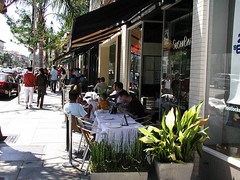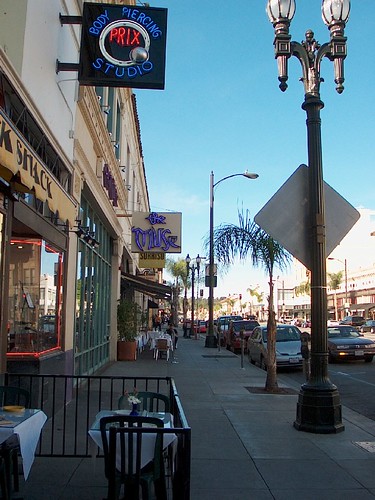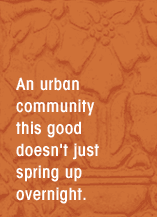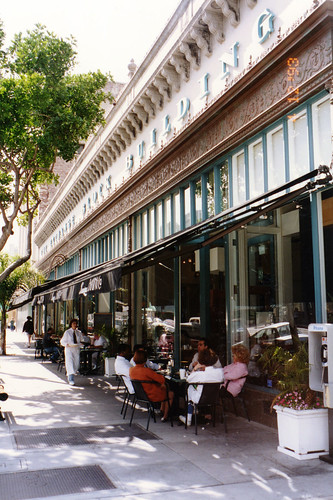We should all be Shoupistas...
 Pasadena Old Town. Photo from Railroad Archive.
Pasadena Old Town. Photo from Railroad Archive. The Muse, Pasadena. Photo from Cap Photos.
The Muse, Pasadena. Photo from Cap Photos.It's too bad that Donald Shoup, a professor of urban planning at UCLA, doesn't teach undergraduates, because he'd likely get amongst the highest teaching evaluations by students of any professor on campus. He's entertaining, but this is merely to get you to reconsider your traditional thinking about parking.
Considering that the dominant planning and development paradigm in the United States is car-centric, you'd think more professors would be looking at the issues around parking. After all, as Dr. Shoup says, a car is parked 95% of the time it's in "use." And you need a parking place for every place you go to with a car--to work, to school, to shop, etc.
 From Yes in my Backyard.
From Yes in my Backyard.The merchants and residents in the Old Pasadena neighborhood of Pasadena, California agreed to pay attention and implement the Shoup parking "philosophy" to great success. Shoup believes that cities should:
1. Charge the right price for curb parking to increase efficiency. Parking should be priced at market prices, and that the optimal market price is determined by that price which ends up leaving 1-2 spaces open per block.
2. Return meter revenue to the Neighborhood/Commercial District that generates it, and use these monies to improve and maintain the public spaces in that area.
3. Not require additional parking when the way a building use changes. Since most communities have suburban-style zoning codes, this hurts buildings in old neighborhoods, because a building's "highest economic use" is stunted by the parking requirement.
Point two is particularly revolutionary, as such money can be used to support Main Street programs as well... Knowing that the money from parking meters would come back to and help pay for improvements to the commercial district led Old Pasadena area merchants, property owners, and residents to embrace parking meters, to which they had previously been adamantly opposed.
 From the Old Pasadena Management District website.
From the Old Pasadena Management District website.By returning meter revenue to the Neighborhood for improvements, instead of creating opponents to change, advocates are created, advocates that work to increase parking meter revenue, if a portion of that revenue stream is directed back to the neighborhood, because they see how the community benefits from having parking readily available, but not hogged by a few users.
Being avaricious folk, Old Pasadena charges for parking at meters til midnite every night and on both Saturday and Sunday. However, there are three city-owned parking structures in this commercial district, and they provide free parking for the first 90 minutes. So people are not forced to the curb and forced to pay every cent they have either.
 EXCHANGE BLOCK BUILDING. Certified Historic Renovation and Adaptive Reuse to multi-tenant retail, restaurant and office project in Old Pasadena, housing the first Mi Piace Restaurant / Pasadena Baking Company and Illuminatiions specialty store. Photo courtesy of the Tolking Group.
EXCHANGE BLOCK BUILDING. Certified Historic Renovation and Adaptive Reuse to multi-tenant retail, restaurant and office project in Old Pasadena, housing the first Mi Piace Restaurant / Pasadena Baking Company and Illuminatiions specialty store. Photo courtesy of the Tolking Group.Shoup also recommends that part of the revenue from parking tickets be redirected to the commercial district-neighborhood from which it is generated as that creates a legion of people committed to enforcement of the laws. (Relatedly, Shoup is amazed at the lack of enforcement of zoning requirements, just based on what he saw during a few hours on a bus tour of the city on Tuesday. Redirecting such ticket and fine revenues back to neighborhoods creates advocates for enforcement and improves "civic engagement.")
For cities not quite willing to take this full step of redirecting parking meter revenues to commercial districts, because cities are using this money now, Shoup proposes that a kind of "Parking Increment Financing" program be developed, where a portion or the entirety (after collection costs) of the increase in revenue deriving from new market-oriented policies is directed back to the neighborhood/commercial district.
When this philosophy was introduced to Old Pasadena, it was a declining and disinvested commercial district, where employees and shop owners hogged the parking places conveniently in front of businesses (there were no parking meters). Businesses opposed installing meters because they said that would drive customers away--but there were few customers. Additionally, the city did not have the money needed to pay for the upgrade of the public space (trees and other plantings, maintenance, sidewalk improvements, street and sidewalk lighting, street furniture, etc.). Installing meters, and directing the revenue to the Old Pasadena commercial district satisfied multiple objectives.
Today, the retail sales tax revenue generated by this shopping district is the highest of all the commercial districts in the city--and all that money goes directly to the city. Click here for the CIty of Pasadena Planning Department webpage on the Old Pasadena Commercial District. Note that not all the changes have been generated by the changes in parking policies. A historic district was created in the late 1970s, and development has been augured by other policies including eligibility of historic preservation tax credits.
Index Keywords: parking



0 Comments:
Post a Comment
<< Home